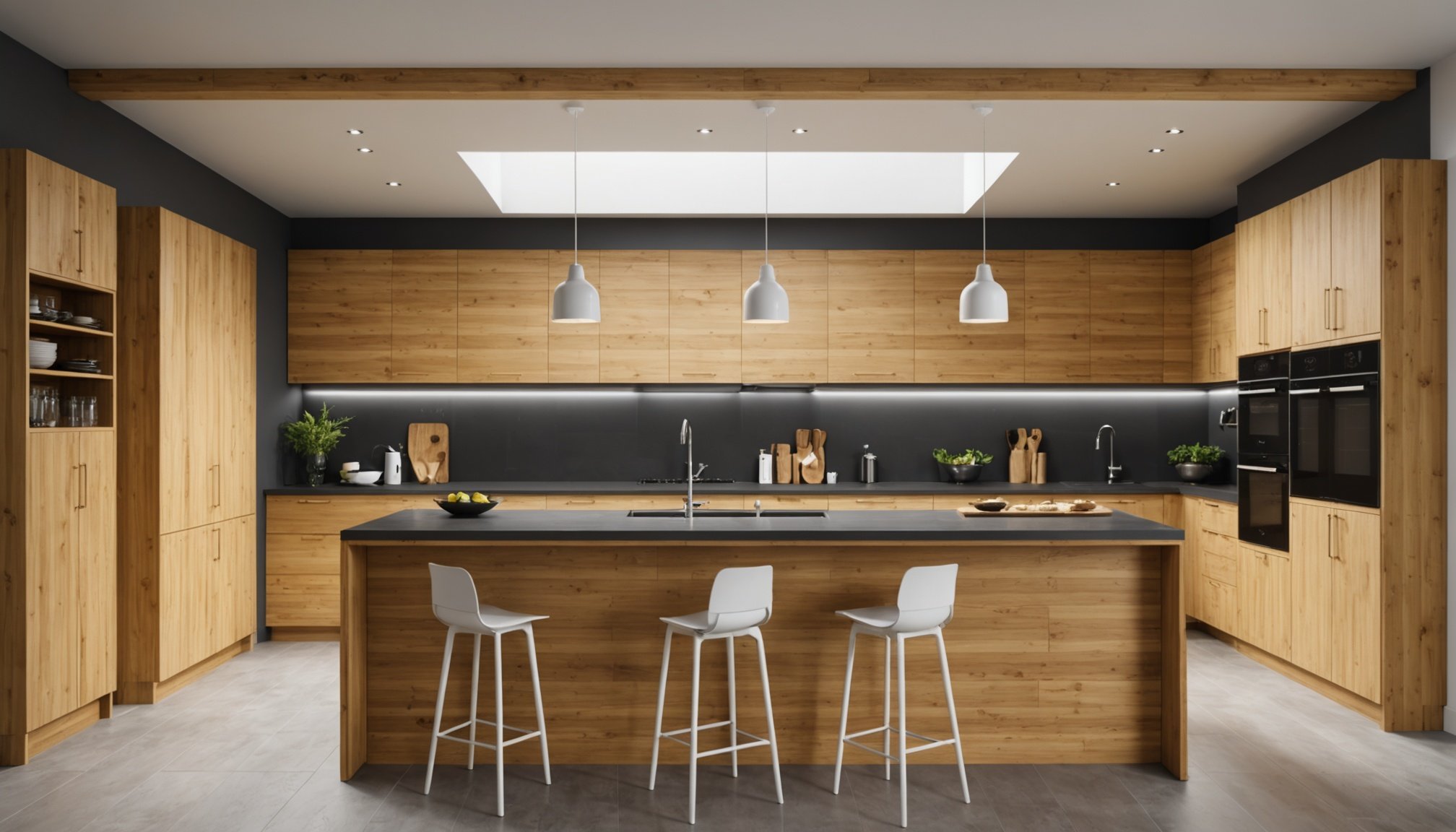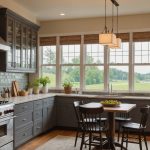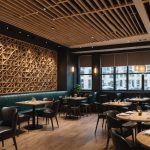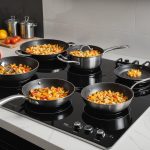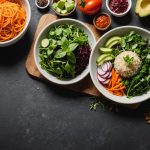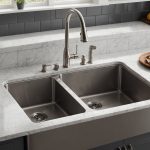Bamboo has emerged as a top-choice material for modern kitchens, blending sustainability with style. This eco-friendly alternative not only reduces your carbon footprint but also introduces warmth and natural beauty to your space. Its versatility allows for various applications, from cabinetry to countertops, ensuring an aesthetic appeal while promoting a healthier environment. Explore how incorporating bamboo can transform your kitchen into a sanctuary of elegance and sustainability, appealing to both your senses and your commitment to the planet.
Environmental Benefits of Bamboo
Exploring the eco-friendly potential of bamboo.
In the same genre : Crafting the Perfect Farm-to-Table Kitchen: Innovative Design Tips for Sustainable Living
Renewable Resource
Bamboo is often celebrated as a highly sustainable material due to its rapid growth and renewability. Unlike traditional timber, bamboo can be harvested in just three to five years, making it a renewable resource that replenishes quickly. This fast growth cycle means less land is required to produce the same amount of material, minimizing its environmental footprint.
Low Environmental Impact
The farming of bamboo is known for its low environmental impact. It requires minimal pesticides and fertilizers, and its root system helps prevent soil erosion. Bamboo also thrives on rainwater, reducing the need for irrigation. This makes it an eco-friendly material choice for those looking to reduce their carbon footprint.
In the same genre : Essential Tips for Caring for Your Wooden Kitchen Utensils: Best Practices for Longevity
Carbon Footprint Reduction
Using bamboo can significantly contribute to carbon footprint reduction. As it grows, bamboo absorbs more carbon dioxide compared to other plants, releasing 35% more oxygen. This natural process makes it a powerful ally in combating climate change.
- Bamboo Sustainability:
- Rapid growth
- Minimal pesticides
- High oxygen release
By choosing bamboo, consumers can make informed decisions that support both the environment and sustainability. This aligns with the rising demand for eco-friendly materials and underscores bamboo's role as a leading renewable resource.
Aesthetic Appeal of Bamboo in Kitchen Design
Exploring bamboo's role in modern kitchen aesthetics.
Versatile Finishes and Colors
Bamboo offers a diverse range of finishes and colors, making it a versatile choice for kitchen design. From light, natural hues to rich, dark stains, bamboo can complement various kitchen styles. This adaptability allows homeowners to achieve their desired look, whether they prefer a sleek, modern kitchen or a cozy, rustic atmosphere.
Integrating Bamboo into Kitchen Styles
Incorporating bamboo into different kitchen styles can enhance both functionality and aesthetics. For a modern kitchen, bamboo's clean lines and minimalist appeal are ideal. In contrast, a rustic kitchen benefits from bamboo's warm tones and natural texture, adding a touch of organic charm.
Inspirational Bamboo Kitchen Designs
To inspire your kitchen renovation, consider these bamboo design ideas:
- Contemporary: Sleek bamboo cabinetry with stainless steel accents.
- Rustic: Bamboo countertops paired with reclaimed wood elements.
- Eclectic: Mix and match bamboo with colorful tiles and bold fixtures.
Bamboo's aesthetic appeal lies in its ability to seamlessly blend with various design trends, making it a popular choice for those seeking a stylish and sustainable kitchen. Embracing bamboo aesthetics can transform your kitchen into a space that is both beautiful and environmentally friendly.
Practical Applications of Bamboo in the Kitchen
Discover the versatility of bamboo in kitchen furnishings.
Bamboo Cabinetry and Countertops
Bamboo cabinetry and countertops are increasingly popular in modern kitchens. Their durability and resistance to moisture make them ideal for kitchen environments. Bamboo's natural grain patterns add a unique touch, providing both aesthetic appeal and functionality. The lightweight nature of bamboo cabinetry ensures easy installation, while its strength supports daily kitchen use.
Bamboo Utensils and Kitchenware
Bamboo utensils and kitchenware offer eco-friendly alternatives to traditional materials. Items such as spatulas, cutting boards, and bowls are not only sustainable but also gentle on cookware surfaces. These accessories are lightweight, easy to clean, and resistant to stains and odors, making them practical additions to any kitchen.
Innovative Uses of Bamboo
Bamboo's versatility extends to innovative applications, such as flooring and backsplashes. Its natural resilience and warmth make bamboo flooring a comfortable option for kitchen spaces. For a modern twist, bamboo backsplashes add texture and depth, enhancing the overall design.
- Bamboo Applications:
- Cabinetry
- Countertops
- Utensils
- Flooring
- Backsplashes
Embracing bamboo in kitchen furnishings and accessories not only supports sustainability but also enhances the kitchen's aesthetic and practical appeal.
Comparisons with Other Materials
Understanding the nuances of material choices.
Durability and Longevity
Bamboo is often compared to traditional hardwoods for its impressive durability. Unlike many hardwoods, bamboo's tensile strength allows it to withstand daily wear and tear, making it a robust choice for kitchen applications. While hardwoods like oak or maple are known for their longevity, bamboo offers comparable strength with the added benefit of being a more sustainable option.
Cost-Effective Advantages
When considering cost, bamboo stands out as a more cost-effective alternative to other materials like laminate. While laminate may initially appear cheaper, bamboo's durability ensures fewer replacements over time, offering long-term savings. Additionally, the rapid growth and renewability of bamboo contribute to its affordability, providing an eco-friendly yet economical choice for kitchen designs.
Maintenance Requirements
Maintenance is another area where bamboo excels. Compared to other kitchen materials, bamboo requires minimal upkeep. Unlike laminate, which can peel or warp, bamboo's natural resilience means it maintains its appearance with simple cleaning.
- Material Maintenance:
- Bamboo: Easy to clean, minimal upkeep
- Hardwood: Requires regular polishing
- Laminate: Prone to peeling, needs careful handling
Choosing bamboo over traditional hardwoods or laminate not only enhances the kitchen's aesthetic but also provides a practical, sustainable solution.
Maintenance and Care for Bamboo Products
Ensuring longevity through proper care and maintenance.
Best Practices for Cleaning
Bamboo care begins with gentle cleaning techniques. To maintain bamboo's natural beauty, use a soft cloth and mild soap. Avoid harsh chemicals that can damage the surface. Regular dusting and occasional wiping with a damp cloth will keep your bamboo items looking pristine.
Preventing Damage
To extend the life of bamboo products, it's crucial to prevent damage. Use coasters and placemats to protect bamboo countertops from heat and moisture. In kitchens, where bamboo surfaces are common, avoid cutting directly on them to prevent scratches. These simple kitchen maintenance tips can significantly enhance bamboo longevity.
Common Misconceptions
There are several misconceptions about bamboo maintenance. Many believe bamboo is fragile, but with proper care, it is incredibly durable. Another myth is that bamboo requires constant upkeep. In reality, bamboo care is straightforward and less demanding than other materials.
- Bamboo Care Essentials:
- Use mild soap and soft cloth
- Protect from heat and moisture
- Avoid direct cutting
By understanding these bamboo care techniques, you can ensure your bamboo items remain in excellent condition, providing both aesthetic appeal and functionality for years to come.
Cost Considerations and Value
Analyzing the financial aspects of incorporating bamboo into kitchen design.
Breakdown of Costs
When planning a kitchen renovation budget, understanding the costs associated with bamboo installations is crucial. Bamboo products, such as cabinetry and countertops, generally have a competitive initial cost compared to traditional materials. While the upfront expense may vary depending on quality and design, bamboo offers a balance between affordability and style.
Long-term Savings
One of the significant advantages of bamboo is its durability, leading to substantial long-term savings. Unlike other materials that may require frequent replacements or repairs, bamboo's robust nature ensures fewer maintenance costs over time. This long-term value makes bamboo a wise investment for homeowners looking to maximize their renovation budget.
Upfront Costs vs. Long-term Value
To better understand the financial benefits, consider the following:
-
Upfront Costs:
-
Competitive pricing
-
Quality and design influence price
-
Long-term Value:
-
Reduced maintenance expenses
-
Extended lifespan compared to alternatives
Opting for bamboo in a kitchen renovation not only aligns with budget-friendly goals but also provides a sustainable and affordable design option. By carefully evaluating both initial and future costs, consumers can make informed decisions that enhance their kitchen's aesthetic and functional appeal.

